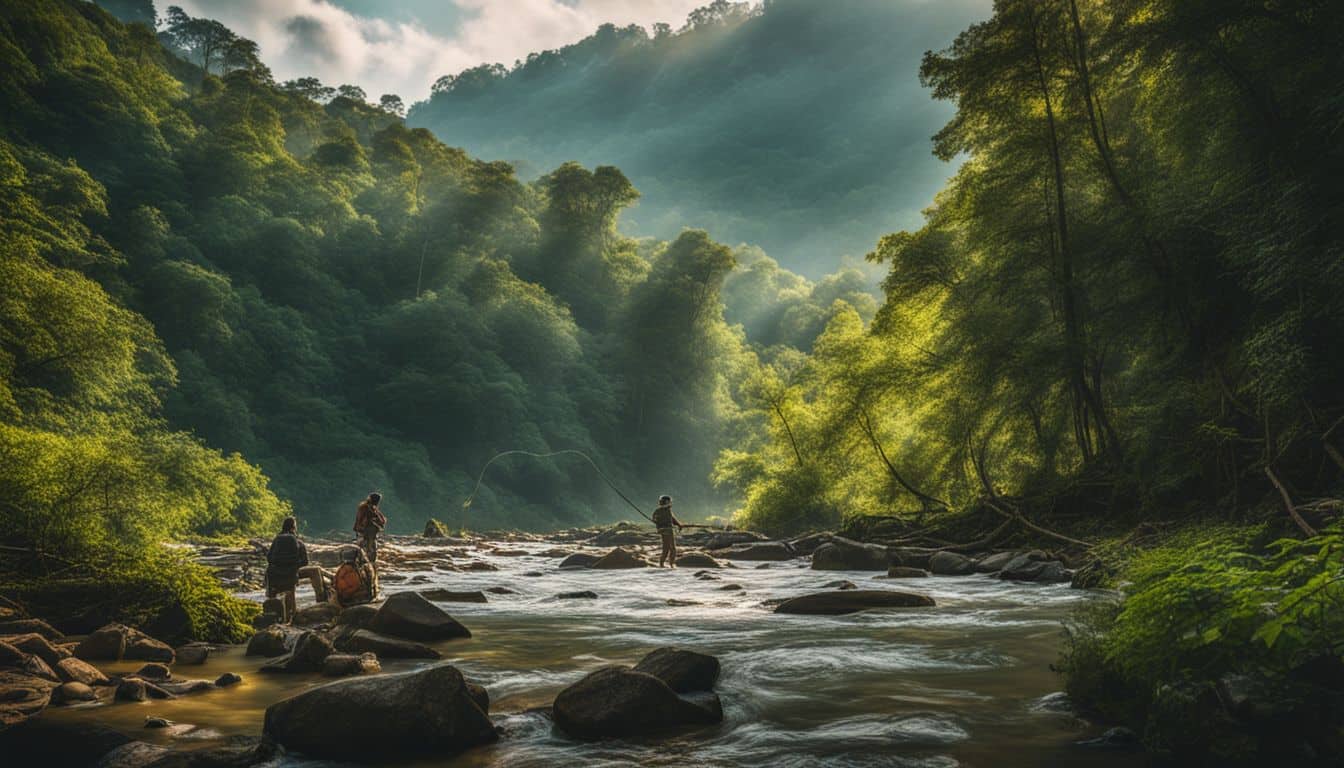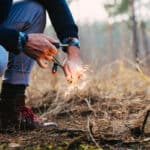Caught without a rod and reel while trying to survive in the wild? You’re not alone. This article will delve into ingenious techniques for snagging fish when traditional gear isn’t an option, equipping you with life-saving knowledge.
Dive in and discover how to become a master of survival fishing!
Table of Contents
- The Importance of Survival Fishing
- Unconventional Methods for Catching Fish
- The Art of Improvising Fishing Gear
- Techniques for Attracting Fish
- The Role of Observation in Survival Fishing
- Preparing Your Catch for Consumption
- Practicing Survival Fishing Techniques
- Essential Fishing Safety Tips
- Conclusion
- Are there Different Techniques for Catching Fish Without Traditional Gear Compared to Without Gear at All?
- FAQs
- FAQ
- What is the best bait to use when I don’t have any fishing gear?
- How do I know where to find fish in unfamiliar waters?
- Can I really catch fish with just my hands?
- What’s the easiest way to make a fishing hook from natural materials?
- Is it safe to eat fish caught in survival situations?
- What’s the best way to cook fish without proper cooking equipment?
- How can I attract fish without traditional lures?
- What time of day is best for survival fishing?
Key Takeaways
- Survival fishing is a critical skill for securing food in extreme conditions and teaches self-reliance and adaptability. Learn to hand fish, create gill nets, dip nets, and spears from natural materials, and utilize plant-based fish poisons.
- You can improvise your own fishing gear when traditional tools aren’t available by fashioning hooks from natural items like bones or wood, making traps out of branches or vines, and using landscape features to corner fish.
- Attracting fish without standard gear involves using bright-colored clothing as lures, turning food scraps into bait, understanding the role of observation in identifying ideal fishing spots, and recognizing patterns in fish behavior.
- Prepare your catch safely by cleaning and gutting it properly before cooking it over an open fire with methods such as grilling on green sticks, heating on flat stones, slow-roasting on a spit or steaming in clay encasing.
- Practicing these survival fishing techniques builds competence for situations where you lack normal equipment. Embrace continual learning to use the environment’s resources effectively to catch fish.
The Importance of Survival Fishing

Survival fishing stands as a lifeline in extreme conditions, offering food and a means to persevere through challenging situations. Knowing how to catch fish with alternative methods becomes an invaluable skill in the unpredictable wild, where traditional fishing gear may be unavailable or impractical.
It empowers individuals to tap into a natural food source abundant in most aquatic environments.
It’s about more than mere sustenance; survival fishing also instills self-reliance and adaptability—traits critical for overcoming adversity. Mastering this skill equips adventurers and survival enthusiasts with the confidence to secure essential nutrition anytime they find themselves near bodies of water.
Whether stranded due to unforeseen circumstances or purposely exploring remote locations, procuring one’s own meal from the water can make all the difference between thriving and merely surviving.
Unconventional Methods for Catching Fish
When the usual fishing gear isn’t within reach, survival calls for ingenuity and a return to some of humanity’s earliest fishing methods. Through creative approaches like hand fishing or constructing make-shift traps, one can still secure food from aquatic sources using unorthodox yet effective techniques.
Hand Fishing
Hand fishing requires skill, patience, and a bit of daring. Also known as noodling or grabbling, it is an ancient method of catching fish using only your hands. This technique is particularly useful in survival situations where traditional gear like rods, lines, or hooks is unavailable.
You simply wade into shallow waters to locate hiding spots such as under logs or in rock crevices where catfish or other species tend to dwell.
To succeed at hand fishing, you must remain still to avoid startling the fish and learn how to quickly snatch the fish out of their hiding places. Feel around gently with your fingers until you make contact with a fish, then swiftly grip it behind the gills or around its body.
Avoiding injury by being mindful of sharp gill covers and possible bites from larger specimens that need handling with extra caution is important. Mastery of this primitive yet effective method can be a game-changer for securing food in wilderness survival scenarios.
Gill Net
Moving from the hands-on approach of hand fishing, a gill net offers another efficient technique for survival situations. This passive fishing method allows you to set up your net in a promising location and leave it to do the work while you focus on other survival tasks.
Gill nets function by ensnaring fish that swim into them; as fish attempt to pass through, they get caught by their gills.
Crafting a makeshift gill net can be straightforward if you have materials like monofilament line or even strong cords available. You’ll want to stretch the net across a waterway—a stream or river edge—and secure it well so that current does not carry it away.
Given its ability to catch multiple fish at once without constant attention, incorporating a gill net into your survival gear strategy could make all the difference in securing enough food for sustenance.
Dip Net
Transitioning from the passive strategy of a gill net, let’s explore the dip net method. A dip net is a handy tool in survival fishing, particularly when you’re stationed by calm pools or slow-moving streams where fish congregate.
To use one, simply hold the handle and plunge the open net into the water near your target. With quick reflexes and precise movements, scoop beneath the fish and lift it out of the water.
Crafting your own dip net can be as simple as attaching a shirt or any piece of cloth to a hoop made from flexible branches or vines. Ensure that your makeshift net is secure enough to handle thrashing fish without tearing.
Mastering this technique gives you an edge in capturing live bait for other types of fishing, such as using hook and line or setting up fish traps. Dip nets are especially useful for swiftly catching small to medium-sized fish without exhausting yourself with more labor-intensive methods like spearfishing.
Fish Spear
Crafting a fish spear from available materials can be a life-saving skill in survival situations. By using resources like pocket knives, scrap metal, or even shards of glass and hard plastic, you can create an effective tool for catching fish.
Chances are you won’t have a fishing pole handy in the wild, so mastering the use of a homemade spear becomes essential.
Aiming accurately with a fish spear takes practice due to light refraction in water that makes the target appear shifted from its actual position. This optical illusion means successful spearfishing requires skills both in crafting and utilizing your improvised weapon effectively.
It’s about adapting quickly – angle your throw while considering how light bends underwater to ensure your aim hits the mark every time.
Fish Poison
Fish Poison might sound unconventional, but it’s an age-old technique practiced by indigenous peoples worldwide. They use natural toxins from specific plants to stun fish without harming the ecosystem.
These plant-based poisons disrupt the fish’s ability to absorb oxygen through their gills, causing them to float to the surface and become easy to collect.
This method requires a keen knowledge of local flora and an understanding of its effects on fish and humans alike. It’s crucial that survival fishermen know exactly which plants are safe for this purpose, as improperly using this technique could have harmful consequences.
Using Fish Poison reflects a deep respect for nature, applying ancestral wisdom while leaving minimal trace behind in wild waters after fishing is done.
The Art of Improvising Fishing Gear
In survival situations, resourcefulness can turn the tide in your favor; learning to craft fishing gear from your surroundings becomes an invaluable skill. Embrace the challenge as we explore innovative ways to create effective fishing tools that capitalize on ingenuity and what nature provides.
Creating Hooks from Natural Materials
Finding yourself without a tackle box doesn’t mean you’re out of luck. You can craft effective fishing hooks from materials found in nature. Here’s how to get creative and fashion your own hooks for survival fishing:
- Grab a strong, sturdy stick or a piece of bone and carve it into a hook shape using a sharp stone or knife.
- Shape thorns or animal bones into gorge hooks, which work by lodging sideways in the fish’s throat.
- Look for small metal pieces like fragments from cans or wire that can be bent and sharpened to form makeshift fish hooks.
- Use naturally curved plant fibers or wood splinters to create improvised hooks when harder materials are unavailable.
- Hollow out seeds or small twigs to make floating bait holders; add bait inside and attach them to your line.
Making Traps from Available Resources
After mastering the craft of creating hooks from nature’s offerings, survivalists can focus on constructing effective traps from the resources at hand. Making your own fish traps is a smart way to secure food without constant monitoring.
- Scout your surroundings for sturdy branches or vines that can serve as the framework for your trap. Look for flexible yet strong materials; willow or bamboo are ideal.
- Intertwine these natural resources to form a fishweir or funnel-like structure, paying attention to creating narrow entrances that guide fish in but prevent them from easily escaping.
- Utilize rocks and heavier objects as anchors to ensure your trap stays submerged and in position within a water current or near a riverbank.
- Incorporate a bait container inside your trap, using whatever food scraps you have, like worms or insects, to lure fish into the enclosure.
- Design an access point allowing you to retrieve caught fish safely while minimizing the chance of other fish escaping during extraction.
- Employ patience by setting up multiple traps in various locations—some spots may yield better results than others due to hidden underwater pathways or preferred fish habitats.
- Regularly check and maintain your traps, repairing any damage and refreshing the baits, which increases your chances of consistent catches over time.
Utilizing Natural Landscapes to Corner Fish
Moving from crafting traps, consider how the surrounding terrain plays a pivotal role in securing your next meal. Rivers and streams with sharp bends are natural spots where fish can be found in higher densities as they navigate the curves.
Position yourself downstream of these bends to take advantage of disoriented fish that might have been slowed down by the current. Look for narrow channels between two water bodies or areas where debris accumulates — fish often pass through or gather here.
Strategically use the lay of the land to guide fish toward shallow waters where they’re easier to catch. Herding them into smaller areas can be done by creating barriers with rocks or logs, effectively funneling them into a designated spot.
Pools left behind after a tide has receded on coastal shores can become temporary holding pens for sea creatures, including fish – making it easier to scoop them up without traditional fishing tackle.
Always assess your environment; its features are invaluable tools that boost your chances of catching fish by working with nature’s design rather than against it.
Techniques for Attracting Fish
Discover innovative ways to lure in your aquatic prey, leveraging unconventional attractants that can turn the tide in survival situations—stay tuned for unique strategies that go beyond traditional bait and tackle.
Using Bright Colored Clothing Scraps as Lures
Bright colors catch a fish’s eye, turning your old clothing scraps into effective lures. Snip pieces of bright fabric, tie them to your fishing line or makeshift trotline, and watch as these makeshift fly-fishing lures dance in the water, mimicking small insects or prey.
Even the smallest sparkle from a piece of jewelry attached can act like an artificial lure—a beacon for curious fish.
Consider how light reflects off your colorful bait under the sun; this visual attraction is key to drawing in your aquatic target. Your survival fishing techniques become more creative as you improvise with available resources—and often just as successful as using traditional gear.
In waters where fish are attracted to color and movement, those vibrant scraps could be just what you need to snag your next meal.
Utilizing Food Scraps as Bait
Utilizing food scraps as bait can be a game-changer in survival fishing scenarios. Not only does this method reduce waste, but it also offers an abundant resource for attracting fish when conventional baits are not available.
You can transform the peels of fruits, bits of bread, or small chunks of leftover meat into effective lures. Simply tie these morsels onto your hook; their natural scents will do wonders in drawing fish closer.
For those who find themselves without traditional hooks, employing creativity is key. Carve makeshift hooks from wood or bone and secure your food scraps to them. Hang your improvised line by a hiding spot where fish gather and wait quietly for a nibble before using swift movements to scoop up your catch with minimal struggle on the line.
With patience and skill, food scraps become valuable assets in securing a meal from the water’s depths, leading seamlessly into understanding how important observation is in survival fishing situations.
The Role of Observation in Survival Fishing
Mastering survival fishing demands keen observation skills—learning to read the water and behavior of fish can significantly increase your chances of a successful catch; delve into our guide for insights on honing this vital instinct.
Identifying Ideal Fishing Spots
To determine where fish are most likely to be found, look for natural structures such as logs, rocks, or overhanging branches. These features provide shelter for fish and often signal a thriving underwater ecosystem.
Scan the water’s surface for ripples or jumping fish; these signs can point you to areas of active feeding. Picking a spot just after a cold front can also pay off since fish behaviors change with weather patterns.
Shallow waters with plenty of sunlight warm faster and can attract schools of fish eager to feed on insects and smaller prey near the surface. Don’t overlook areas where streams flow into larger bodies of water; these junctions are hotspots for various species looking for oxygen-rich currents carrying potential food sources.
Up next: Recognizing patterns in how fish behave could further enhance your chances of survival fishing success.
Recognizing Patterns in Fish Behavior
Observing fish behavior is like unlocking a hidden language of survival in the wild. Fish follow routines that are influenced by weather, water temperature, and available food sources.
By understanding these habits, you can predict where and when fish are most likely to bite. This knowledge is not only useful for catching dinner but also vital for anyone relying on survival fishing techniques.
Mastering the art of pattern recognition involves patience and keen attention to detail. You might notice certain species prefer the shadowed areas under overhanging branches or rocks during midday heat.
Others may be more active at dusk or dawn, cruising shallower waters in search of their next meal. Identifying these patterns gives you an edge, allowing you to tailor your approach with improvised gear such as spears from natural materials or simple handmade traps.
Engaging with this rhythm of nature elevates your chances of success without needing conventional fishing rods or artificial lures.
Preparing Your Catch for Consumption
Once you’ve successfully secured your fish through survival techniques, it’s essential to know the safe and effective methods for preparing it – a skill that could turn a critical situation into a nourishing one; stay tuned to uncover these vital survival skills.
Safely Cleaning and Gutting Fish
Cleaning and gutting your fish properly is crucial for safe consumption. Here are essential steps to ensure you prepare your catch without risking foodborne illnesses.
- Find a flat, clean surface to work on, preferably away from your campsite to avoid attracting predators.
- Use a sharp knife or improvised blade for precision and safety. A dull tool can be dangerous and less effective.
- Cut through the fish’s belly starting from the anus up towards the head, being careful not to puncture the intestines.
- Remove all internal organs by pulling them out gently. Dispose of them responsibly, far from your living area.
- Check the cavity for any remaining blood or debris and rinse with freshwater if available.
- Slice off the head or keep it based on your preference; some survivalists use fish heads for making nutrient-rich broth.
- Remove scales by scraping from tail to head with the back of your knife or a flat stone if necessary.
- Clip off fins and tail using scissors, if you have them, or carefully cut with your knife.
- Make sure there are no remains of innards as these can harbor parasites that might cause illness.
- Finally, fillet the fish if desired or cook whole over an open fire or improvised stove.
Simple Methods for Cooking Fish in the Wild
Once you have your fish cleaned and gutted, it’s time to turn them into a delicious meal. Out in the wild, you can’t rely on a kitchen stove, but with some creativity, you can still cook fish successfully over an open flame.
- Create a Simple Grill: Find green sticks or branches that can be placed over hot coals. Lay the fish on top of these green sticks to prevent sticking and allow for even cooking from the heat below.
- Make Use of Flat Stones: Locate large flat stones and place them near your fire to heat up. Once they’re hot, set your fish on top for a no-fuss grilling surface.
- Craft a Spit: Sharpen both ends of a long stick, skewer the fish through its mouth and out its tail, then position it horizontally over the fire. Rotate slowly to ensure even roasting.
- Construct an Earth Oven: Dig a small pit in the ground that’s big enough to fit your fish wrapped in leaves or wet newspaper if available. Place heated rocks inside the pit, add your wrapped fish, cover with more hot stones and soil, and let it bake.
- Steam in Clay: Covering cleaned fish in clay might seem unusual but it’s effective. Once covered, place it directly into low embers. The clay hardens as it cooks and locks in moisture – crack it open when done to reveal steamed flesh.
- Pan Fry with Makeshift Pans: If you have any metal item like a flat rock or piece of aluminum, fashion this into a rudimentary pan. Add thin slices of fish seasoned with whatever herbs are at hand before placing over an indirect heat source until cooked through.
Practicing Survival Fishing Techniques
Mastering survival fishing skills ensures you’re prepared for any situation where traditional gear is not available. Begin with simple techniques such as making a basic spear from a straight stick to catch nearby fish, or creating a hook using natural materials like bone or wood.
Learn how to twine dental floss into sturdy fishing lines and set up trot lines across a stream to maximize your chances of catching fish.
Consistent practice turns these methods into valuable tools in your survival skillset. Experiment with crafting different types of traps out of branches and leaves, then place them in strategic locations to capture unsuspecting fish.
Understand the importance of stealth and patience as you quietly wade through waterbodies, practicing hand fishing where permitted. These hands-on experiences build confidence in your ability to secure food no matter what challenges nature may present.
Essential Fishing Safety Tips
While fishing is an enjoyable outdoor activity, it’s important to prioritize safety. Here are some essential tips to keep in mind:
- Always wear a properly fitted life jacket, especially when fishing from a boat or near deep water. Don’t just have it in the boat – actually wear it.
- Be cautious when handling hooks and removing fish. Look around before casting to avoid hooking someone. Consider using barbless hooks for easier removal.
- Wear nonslip shoes to avoid slips and falls on wet surfaces. Closed-toe shoes also protect feet from sharp objects and fish spines.
- Check weather forecasts and be prepared for changing conditions. Have rain gear and extra layers on hand. Avoid fishing in storms.
- When fishing with children, provide constant supervision and consider using a buddy system. Make sure kids wear life jackets around water at all times.
- Protect yourself from the sun with a hat, sunglasses, and high-SPF sunscreen, even on cloudy days. Stay hydrated and take breaks in the shade.
- Bring a well-stocked first-aid kit to treat potential injuries, such as cuts, scrapes, hook removals, and insect bites or stings.
- Be aware of your surroundings and any potential hazards like slippery rocks, strong currents, tides, or dangerous wildlife in the area.
- Avoid consuming alcohol or drugs while fishing, as they can impair judgment, balance, and reaction time, increasing the risk of accidents.
By following these safety guidelines, you can minimize risks and focus on enjoying your fishing adventure. Remember, a little preparation and caution go a long way in keeping you and your fishing companions safe on the water.
Conclusion
Get ready to embrace the challenge of survival fishing using creativity and resourcefulness. With a bit of practice, anyone can learn these ingenious techniques for securing a meal in the wild.
Remember, nature offers all we need; it’s about seeing the potential in what’s around us. Happy fishing and here’s to adding another skill to your outdoor adventures arsenal! Whether you’re crafting makeshift gear or attracting fish with unconventional baits, each catch is a triumph of adaptability and ingenuity.
Are there Different Techniques for Catching Fish Without Traditional Gear Compared to Without Gear at All?
When it comes to techniques for survival fishing, there are definitely different methods for catching fish without traditional gear compared to catching fish without any gear at all. Without traditional gear, you might use makeshift tools or natural resources, while catching fish with no gear requires more skill and patience.
FAQs
What are some techniques for survival fishing without traditional gear?
You can try spear fishing or make a simple line and hook using materials found in nature. These methods require patience and skill but can be effective when you don’t have your regular fishing gear.
Can I use items from my bug-out bag for survival fishing?
Yes! Items commonly found in a bug-out bag, like knives, safety pins, or even shoelaces, can be adapted to create makeshift fishing tools that might just help you catch fish in a pinch.
Is blasting caps a safe method for catching fish in a survival situation?
No, using blasting caps is not safe and is considered illegal due to the danger it poses to both the person and the environment. Always prioritize safety by choosing safer alternative methods.
How do I learn more about making DIY fishing gear in emergency situations?
Look into reliable resources such as WikiHow, which provides step-by-step guides, or add an RSS reader app to your device to receive regularly updated information on crafting handmade fishing equipment. from trusted sources like Wikipedia.
FAQ
What is the best bait to use when I don’t have any fishing gear?
In a survival situation, you can use various food scraps as effective bait to attract fish. Fruit peels, bread pieces, and small chunks of leftover meat can all serve as natural attractants. Simply secure these food items to your improvised hook, and their natural scents will help draw fish closer to your position.
How do I know where to find fish in unfamiliar waters?
Look for specific features in the water that naturally attract fish. Focus on areas with logs, rocks, or overhanging branches, as these provide shelter for fish. Also target spots where streams flow into larger bodies of water, as these junctions typically have oxygen-rich currents that attract various fish species.
Can I really catch fish with just my hands?
Yes, hand fishing (also known as noodling or grabbling) is an effective ancient technique that requires no equipment. Wade into shallow waters and gently feel around hiding spots like logs or rock crevices where fish tend to dwell. When you locate a fish, grip it firmly behind the gills or around its body. However, exercise caution as some fish have sharp gill covers and may bite.
What’s the easiest way to make a fishing hook from natural materials?
You can craft functional hooks using items found in nature. Strong sticks or bones can be carved into hook shapes using a sharp stone or knife. Thorns can be shaped into gorge hooks, which work by lodging sideways in the fish’s throat. Even naturally curved plant fibers or wood splinters can serve as improvised hooks when harder materials aren’t available.
Is it safe to eat fish caught in survival situations?
Yes, but proper preparation is crucial. Clean your catch on a flat surface away from your camp to avoid attracting predators. Cut carefully from the anus to the head, remove all internal organs, and check for remaining blood or debris. If possible, rinse with fresh water. Make sure to remove all innards as they can contain harmful parasites.
What’s the best way to cook fish without proper cooking equipment?
Several effective methods exist for cooking fish in the wild. You can create a simple grill using green sticks placed over hot coals, use heated flat stones as a cooking surface, or craft a spit by skewering the fish through its mouth and out its tail. For a unique approach, try steaming the fish by encasing it in clay and placing it in hot embers – the clay will harden and lock in moisture while cooking.
How can I attract fish without traditional lures?
Bright-colored clothing scraps can serve as effective makeshift lures. Cut small pieces of colorful fabric and attach them to your fishing line. The movement of these scraps in the water mimics small insects or prey fish. Even small pieces of jewelry can work as they create attractive sparkles underwater that catch fish’s attention.
What time of day is best for survival fishing?
Fish are most active during dawn and dusk when they typically cruise in shallower waters searching for food. During midday heat, look for fish in shadowed areas under overhanging branches or rocks. Understanding these daily patterns helps maximize your chances of success when fishing for survival.






Leave a Reply